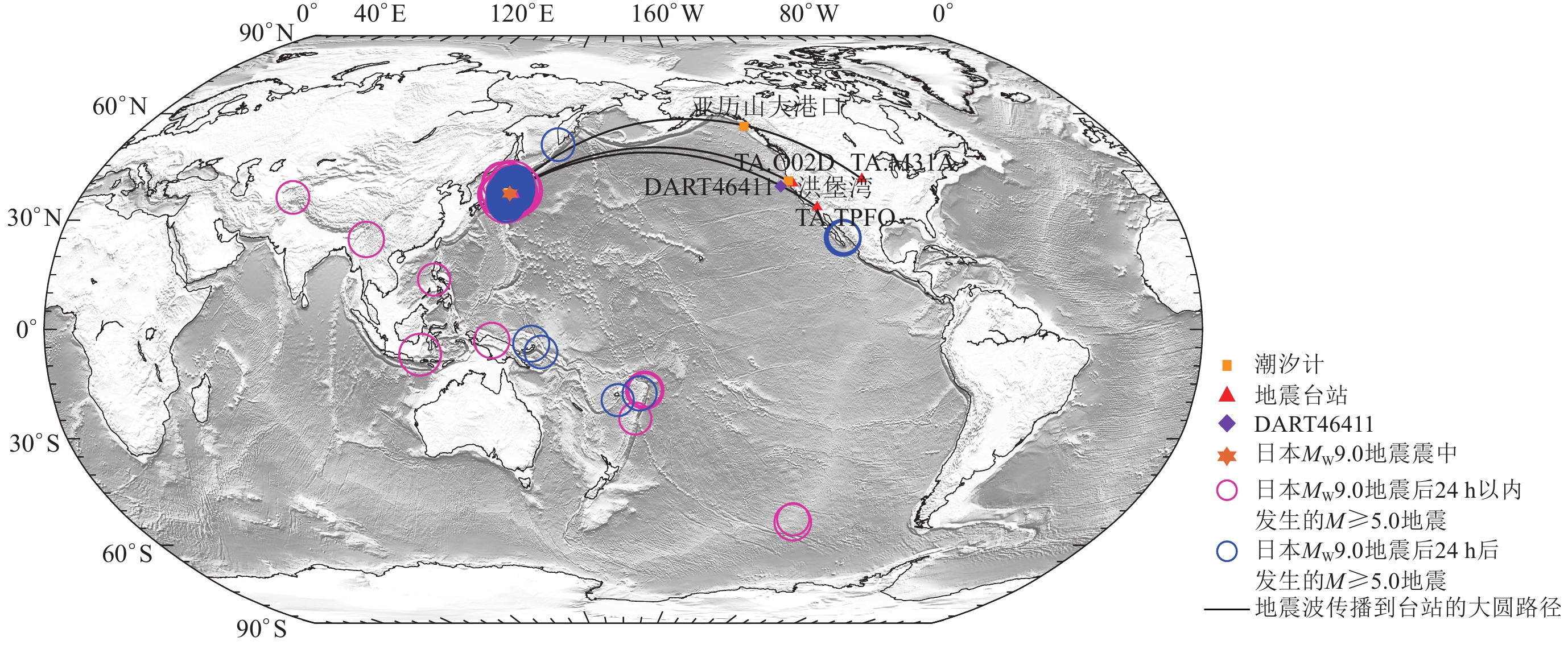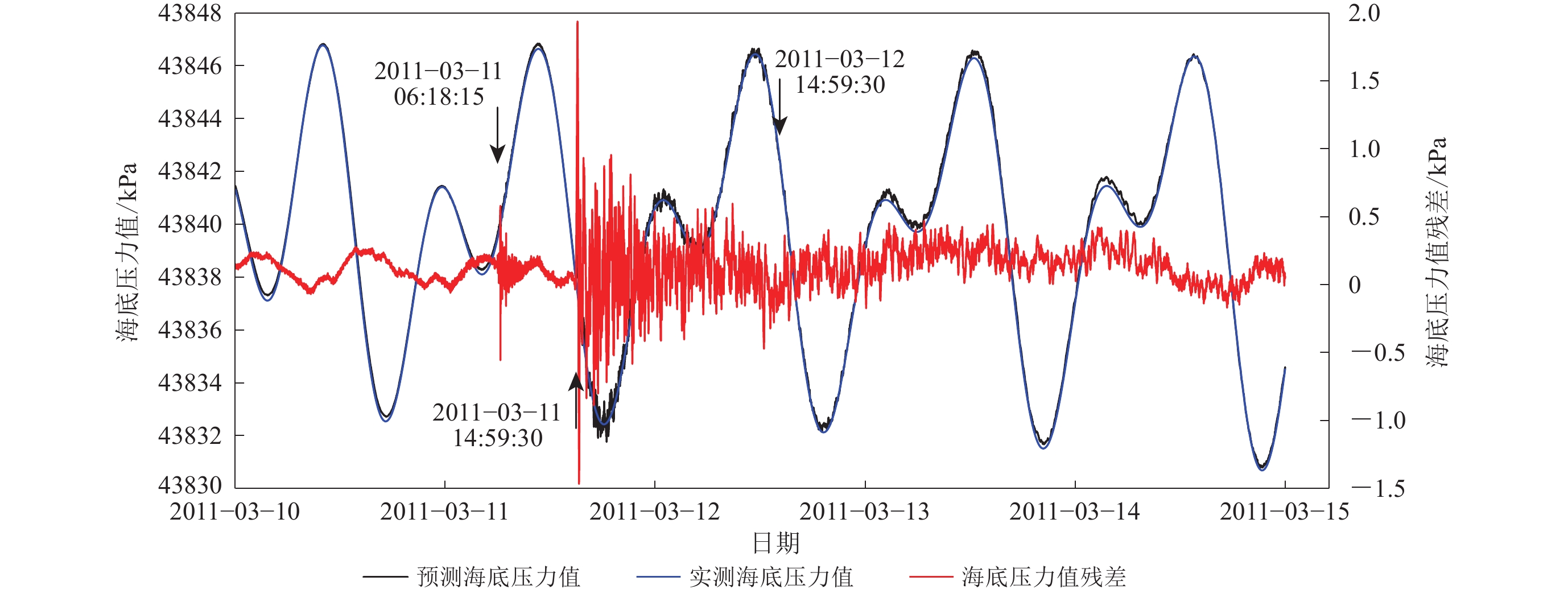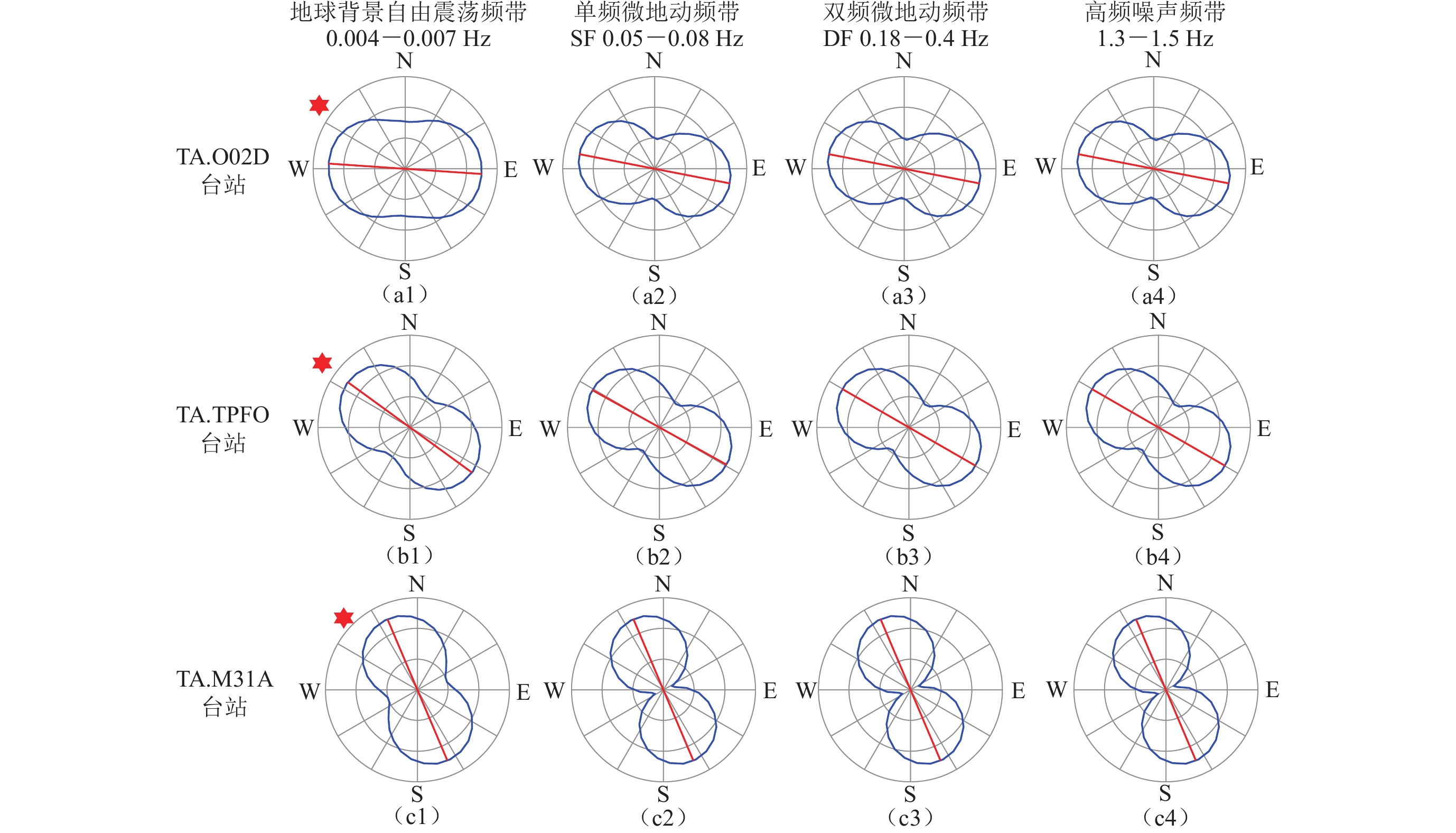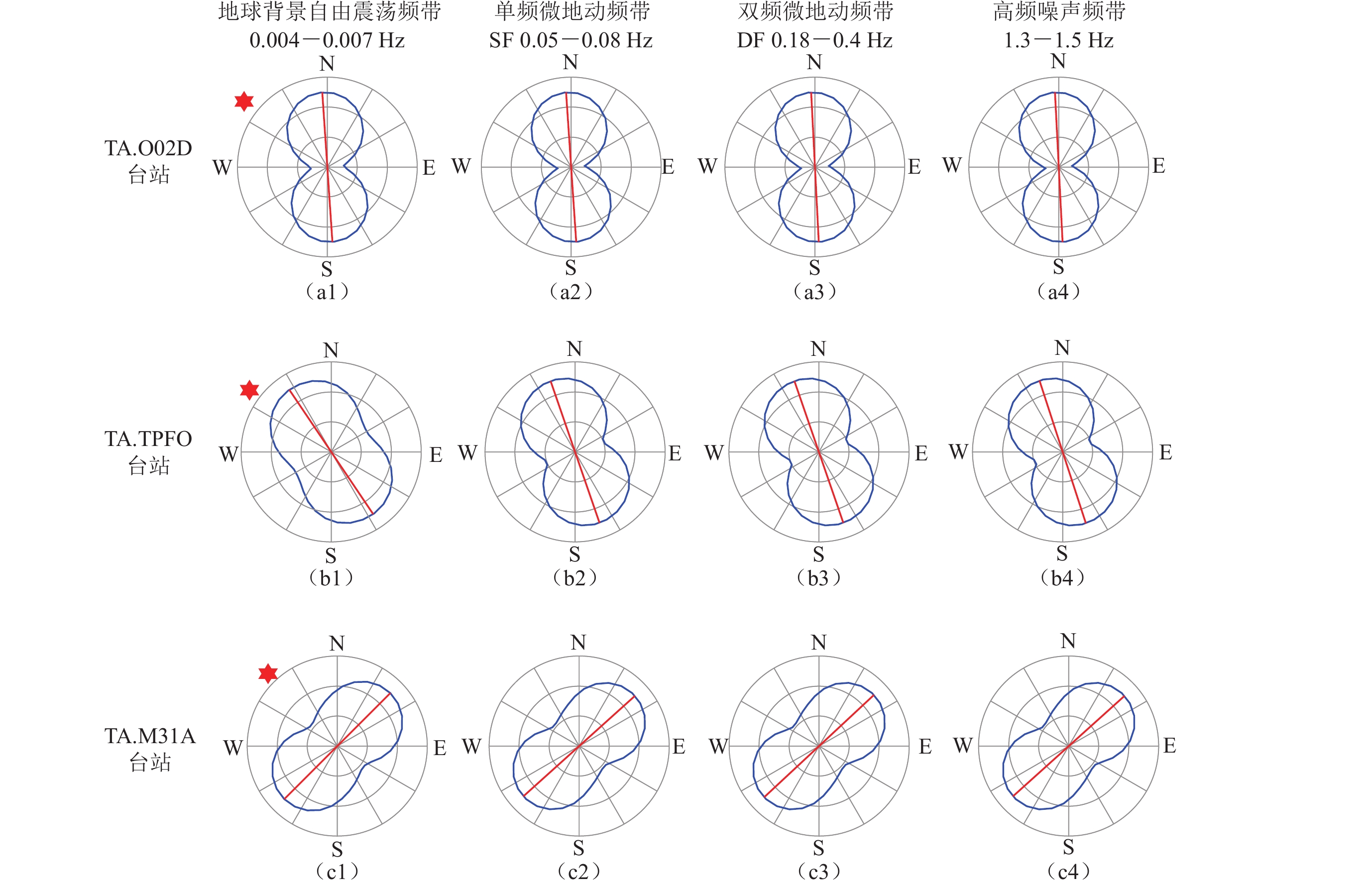Impact of the tsunami excited by the 2011 MW9.0 Japan earthquake on seismic ambient noises
-
摘要: 基于北美沿岸和内陆地震台站的连续地震波形记录,并结合沿岸台站附近布设的DART系统记录的海底压力数据以及预测潮汐数据,利用时频分析和极化分析方法对2011年3月11日日本东北部海域MW9.0大地震所激发的海啸对地震背景噪声所产生的影响予以深入分析。结果显示:海啸对高频噪声(1.3—1.5 Hz)以及短周期双频微地动噪声(0.18—0.4 Hz)的影响较小,但海啸显著增强了长周期双频微地动(0.1—0.15 Hz)、单频微地动(0.05—0.08 Hz)以及地球背景自由振荡(0.004—0.007 Hz)的振幅,且随着噪声频率的降低,这种振幅增强的影响更明显,影响的持续时间也更长;海啸到达近岸时,对附近台站的各频段噪声均有影响,成为各频段噪声的主控能量来源,且其位置在后续过程中会随时间变化。这表明海啸对噪声特征的影响与海啸传播特性有关,即海啸在传播过程中因受水深、海底地形以及近岸地形的反射、衍射等的影响,能量聚集区域随时间而变化,并非均匀地传播到海岸, 从而导致了不同频带噪声主极化方向随时间的变化。
-
关键词:
- 海啸 /
- 2011年日本MW9.0地震 /
- 地震背景噪声 /
- 地球背景自由振荡 /
- 微地动
Abstract: The MW9.0 earthquake on March 11, 2011 occurred in the northeastern sea of Japan triggered a catastrophic tsunami, which had significant influences on the seismic ambient noises with ocean-lithosphere coupling. This study uses the continuous data recorded by seismic stations along the coast and inland of North America, combined with the seafloor pressure data recorded by the DART system nearby, as well as the predicted tidal data to analyze the impact of this tsunami on the seismic ambient noises by using time-frequency analysis and polarization analysis methods. The results show that this tsunami had little impact on the high-frequency noise (1.3−1.5 Hz) and short-period double-frequency microseisms (0.18−0.4 Hz), while it significantly enhanced the amplitudes of long-period double-frequency microseisms (0.1−0.15 Hz), single-frequency microseisms (0.05−0.08 Hz), as well as the Earth’s background free oscillations (0.004−0.007 Hz). Moreover, as the frequency of the ambient noise decreases, the amplitude enhancement becomes more pronounced and lasts longer. When the tsunami reaches the shore, it has an impact on the ambient noise of coastal stations nearby for all three frequency-bands of Earth’s background free oscillations, microseisms, and high-frequency noise and becomes the main energy source of seismic ambient noises at all three frequency bands. And the position of the dominant tsunami sources changes with time. All above-mentioned suggests that the influence of tsunami on seismic ambient noise is related to the propagation characteristics of tsunami, that is, due to the influence of water depth, reflections and diffractions of seafloor and inshore topography, the energy accumulation area changes with time, and the energy does not propagate uniformly to the coast, resulting in the changes of dominant polarization direction of seismic ambient noise in different frequency bands with time. By cross-disciplines of seismology and oceanography, this study is of significance for advancing studies on the coupling mechanism of ocean-lithosphere, identifying the characteristics of tsunami waves from the perspective of seismology, as well as exploring new tsunami warning mechanisms. -
引言
海啸是联合国“国际减灾十年”所确定的全球重大自然灾害之一,它严重地威胁着沿海地区的安全。2011年3月11日5时46分24秒(UTC),在日本东北部海域发生MW9.0地震,该地震导致大约长450 km的日本海沟发生破裂,同时也引发了一场毁灭性的海啸,给太平洋沿岸地区造成了巨大的灾难(Fujii et al,2011)。
海啸是一种海洋重力波,其在传播过程中由于受到水深变化、海底地形以及近岸地形的反射、衍射等的影响,其传播路径随时间变化,表现为海啸能量的各向异性扩散(Titov et al,2005;Fine et al,2013;Shevchenko et al,2014)。由于海啸现象较为复杂,对海啸的形成机制、传播特征以及海啸源的定位等仍然存在诸多争议(Titov et al,2005;Fujii,Satake,2007;Fujii et al,2011)。早期研究对海平面的测量主要是沿岸记录(Pugh,Woodworth,2014),但是后续研究显示,在沿海地区,非线性、摩擦、混叠、仪器噪声、温度变化和风浪的影响会使海啸信号本身失真,这使得海啸监测更加复杂化,面临的挑战也更艰巨(Mungov et al,2013;Pugh,Woodworth,2014)。
海啸与地震有着密不可分的关系。据不完全统计,全球90%左右的海啸事件是由海底地震引发(叶琳等,2005)。通过海啸波形分析,能够推算引发海啸的地震震源参数(Fujii,Satake,2007;Satake et al,2013)。此外,海洋也是地球背景自由振荡、微地动和高频P波噪声的来源(Longuet-Higgins,Ursell,1948;Nishida et al,2000;Ekström,2001;Watada,Masters,2001;Rhie,Romanowicz,2004;Bromirski et al,2005;Xiao et al,2018),这表明海啸也会引起地震背景噪声的变化,通过揭示这种关联有望从新的角度来加强对海啸的监测。
地震背景噪声按周期从长到短可以分为地球背景自由振荡、微地动和更高频的地震噪声,目前对地震背景噪声的研究集中在反映大气-海洋-地球之间大尺度耦合的地球背景自由振荡(2—7 mHz)和微地动(0.05—0.5 Hz)上,并建立了较为系统的理论来阐述这些噪声的激发机制(Rhie,Romanowicz,2004;Rhie,Romanowicz,2006)。实际上,地球背景自由振荡和微地动都是地震台站所记录到的地面运动,由于这些运动是由天然地震以外的“震源”引起的,在以研究天然地震为主的记录上表现为需要被去除的背景噪声,因此通常将其统称为地震背景噪声.
地震观测研究显示,在没有地震的影响下仍然存在长周期的地面振动,即地球背景自由振荡(2—7 mHz) (Benioff et al,1959;Gilbert,MacDonald,1959;Kobayashi,Nishida,1998;Suda et al,1998),其来源最初被认为是大气的干扰(Kobayashi,Nishida,1998;Nishida,Kobayashi,1999;Tanimoto,Um,1999;Fukao et al,2002),后来关于地球背景自由振荡的季节性变化以及海底压力变化谱与地震噪声谱之间的相似性等方面的研究结果表明,海洋是地球背景自由振荡的来源(Nishida et al,2000;Ekström,2001;Watada,Masters,2001;Rhie,Romanowicz,2004;Webb,2007),Tanimoto (2005)基于此建立了海洋作为地球背景自由振荡噪声源的模型。
而这里提到的微地动并非是微小地震,而是海洋活动通过海陆耦合引发的连续地震波形记录上频率处于0.05—0.5 Hz的噪声(Longuet-Higgins,1950;Hasselmann,1963;Cicconi et al,1983;Bromirski et al,2005)。微地动一般分为两个频带:0.05—0.08 Hz的单频微地动和0.1—0.5 Hz的双频微地动,而且双频微地动的峰值有时会分裂成两个,其中峰值出现在0.1—0.15 Hz频带的被称为长周期双频微地动,峰值大约出现在0.18—0.4 Hz频带的被称为短周期双频微地动(Tanimoto,2007;Bromirski,Gerstoft,2009;Zhang et al,2010a;Sun et al,2013;Koper,Burlacu,2015)。一般认为单频微地动通过海浪的破裂及其对海岸的直接影响而在浅水中激发;双频微地动则由两列传播方向相反且频率相同或相近的波列,通过非线性波-波相互作用所激发,其频率是单频微地动的两倍,且其能量一般比单频微地动大得多(Longuet-Higgins,1950)。长周期双频微地动可能的源区有海岸(Bromirski et al,2005;Stehly et al,2006;Tanimoto et al,2006;Bromirski,2009)或开放大洋(Obrebski et al,2012),短周期双频微地动可能是由台站附近的重力波非线性作用所激发(Bromirski et al,2005),但也有可能是不同源区激发的特定频率微地动的叠加造成了微地动的分裂(Koper,Burlacu,2015),目前微地动分裂的机理仍不清楚。
除了地球背景自由振荡和微地动,连续地震波形记录上有时候会记录到更高频段(0.4—6 Hz)的高频噪声,其在地震背景噪声谱上的部分被称为火鲁(Holu)谱,这可能是由局部海洋风激发的海浪与海底作用而产生(McCreery et al,1993;Bromirski et al,2005;Sun et al,2013)。目前已有部分研究识别出火鲁谱内0.6—2.0 Hz频段的P波噪声(Gerstoft et al,2008;Zhang et al,2009,2010a,b),但高频P波地震噪声的产生机理尚不确定,Zhang等(2009,2010a)和Sun等(2013)认为这种噪声是由本地近海风通过风生海浪所激发。
目前地震背景噪声的源定位于海洋,其形成机制归因于海浪之间以及海浪与固体地球之间的相互作用,而海啸事件作为海浪运动的一种极端形式,是对整个海洋产生影响的大事件,其对连续地震波形记录上的背景噪声具有不可忽视的影响。但是,当前对海啸事件在连续地震波形记录的特征却知之甚少。关于海啸的地震学特征及其对地球背景自由振荡、微地动以及高频噪声的影响都是亟需研究的重要内容。
鉴于此,本研究以2011年3月11日日本东海岸MW9.0强震引发的海啸为例,详细阐述该海啸事件对上述三类地震背景噪声的影响,试图从连续地震波形记录中拾取海啸,以期为海啸预警、海啸物理学、背景噪声的应用以及海洋-固体地球系统耦合机制研究提供参考。
1. 数据和方法
1.1 数据
本研究从美国地震学研究联合会(Incorporated Research Institutions for Seismology,缩写为IRIS)网站https://ds.iris.edu上下载了宽频地震台站TA.O02D,TA.M31A和TA.TPFO从2011年3月10日至2011年3月15日的连续地震波形记录,台站位置分布如图1所示。台站选择基于以下考虑:选择距离震源较远的台站,利用海啸波与地震波之间的传播速度差,通过较远距离的传播,得到与主震激发的地震波分离较好的海啸波所激发的地震信号。此外,本研究还收集了地震台站附近深海评估和海啸预报系统(Deep-Ocean Assessment and Reporting of Tsunamis,简写为DART) DART46411的海底压力数据(图1),基于此得到海啸首波到达台站较精确的时刻。研究中还需要考虑潮汐的影响,潮汐预测数据源于美国海洋及大气管理局(National Oceanic and Atmospheric Administration,缩写为NOAA)网站https://www.noaa.gov。
![]() 图 1 本文所用的地震台站、DART站、潮汐计以及2011年3月10日至3月15日期间全球M≥5.0地震震中位置的空间分布图(圆圈大小表示地震震级的相对大小)Figure 1. The spatial distributions of seismic stations,DART station and tide meters used in this study as well as the global M≥5.0 earthquake epicenter locations from March 10 to 15,2011 (The circle size indicates the relative magnitude of the earthquake)
图 1 本文所用的地震台站、DART站、潮汐计以及2011年3月10日至3月15日期间全球M≥5.0地震震中位置的空间分布图(圆圈大小表示地震震级的相对大小)Figure 1. The spatial distributions of seismic stations,DART station and tide meters used in this study as well as the global M≥5.0 earthquake epicenter locations from March 10 to 15,2011 (The circle size indicates the relative magnitude of the earthquake)1.2 方法
1.2.1 时频分析
为了研究海啸在连续地震波形记录上的特征,本文应用时频分析方法来分析连续地震波形记录。对于每个连续地震波形记录,首先进行预处理,包括去均值、去线性趋势、去仪器响应,并进行0.004—4 Hz的带通滤波(考虑到本研究中宽频带地震仪的最长有效周期为240 s)(图2a);然后将连续地震波形记录分解为连续半小时的时间序列,对其进行快速傅里叶变换,以获得它们各自的频谱;最后按时间顺序排列这些频谱,得到连续地震波形记录的时频图,如图2b所示。
![]() 图 2 2011年3月10日至15日TA.O02D台站垂直分量的时频分析结果(a) 波形图;(b) 时频图;(c) 不同频段的半小时平均振幅A曲线;(d) 微地动频带内不同频段的半小时平均振幅A曲线。图(c)和(d)中红色圆圈表示M≥5地震的发生时刻和震级大小。地震目录引自美国国家地震信息中心(USGS,2020)Figure 2. Time-frequency analysis results of the vertical component of the station TA.O02D from March 10 to 15,2011(a) Waveform diagram;(b) Time-frequency diagram;(c) Half-hour average amplitude curves in different frequency bands;(d) Half-hour average amplitude curves of different frequency bands in microseisms. In Figs. (c) and (d),red circles indicate the time and magnitude of M≥5 earthquakes. Earthquake catalogue comes from USGS (2020)
图 2 2011年3月10日至15日TA.O02D台站垂直分量的时频分析结果(a) 波形图;(b) 时频图;(c) 不同频段的半小时平均振幅A曲线;(d) 微地动频带内不同频段的半小时平均振幅A曲线。图(c)和(d)中红色圆圈表示M≥5地震的发生时刻和震级大小。地震目录引自美国国家地震信息中心(USGS,2020)Figure 2. Time-frequency analysis results of the vertical component of the station TA.O02D from March 10 to 15,2011(a) Waveform diagram;(b) Time-frequency diagram;(c) Half-hour average amplitude curves in different frequency bands;(d) Half-hour average amplitude curves of different frequency bands in microseisms. In Figs. (c) and (d),red circles indicate the time and magnitude of M≥5 earthquakes. Earthquake catalogue comes from USGS (2020)由于此次日本MW9.0地震的震级较大,所产生地震波的频率范围较宽,低频成分不少,可能存在与海啸事件产生的信号重叠的频带,于是本文以多种处理方式尝试压制主震强振幅的影响。例如,采用绝对均值归一化方法对连续地震波形记录进行归一化处理(Bensen et al,2007),以减弱地震发生时刻较强的地震能量,但出现了过校正的现象,并未取得预想的效果;又如,从实际观测的连续地震波形记录中减去正演所得的此次地震的理论连续地震波形记录,以消除大地震的影响,但是由于IRIS提供的理论合成连续地震波形记录与实际观测的连续地震波形记录的匹配度不够,也未能取得预想的效果。地震台站能够记录到由主震直接激发的地震波,以及由主震激发的海啸波传播到地震台站附近海域后与海岸作用所激发的地震波。由于本文所选取的地震台站和主震分别位于太平洋两岸,考虑到地震波与海啸波传播速度的差异,我们能够使两种不同激发机制所产生的地震信号在连续地震波形记录的时域上拉开距离。地震激发的地震波记录通常小于一个小时,在连续地震波形记录的时频分析图中仅占1到2个数据点,表现为尖峰(Sun et al,2013)。但此次引起海啸的日本大地震的矩震级高达MW9.0,震源持续时间超过三分钟(Ye et al,2013),直至震后近一天还能观测到该地震激发的绕地球表面传播的全球面波,不过后续的全球面波的到时有规律可循,且幅度显著降低,因此,本文选取距离震中较远的地震台站,以期在时域上能凸显海啸的特征,降低主震所激发的地震信号的影响。为便于比较,我们还在时频图上绘制了M≥5.0地震的发生时间,如图2c和2d所示。
1.2.2 极化分析
为了研究海啸激发地震波的源区,本文采取极化分析方法对地震台站接收到的三分量记录在不同频段进行极化分析,以此来判断该频段的能量从哪个方位到达地震台站,从而对不同频带的源区方位有个大致了解。与此同时,使用主极化方向方法来研究地震台站接收到的不同频带能量的到达方位(Rhie,Romanowicz,2006;Zhang et al,2010a)。在台站数目较少时,该方法比较有效(Sun et al,2013)。
应用主极化方向方法获取能量到达方位的具体过程如下:① 针对每个台站的水平分量记录中正北和正东分量的记录,从0°到360°以1°为间隔进行旋转;② 对所有旋转后的连续地震波形记录进行快速傅里叶变换得到其频谱;③ 计算不同旋转角度下目标频带内连续地震波形记录的平均振幅;④ 在目标频带内比较不同方位角的平均振幅大小,确定目标频带地震背景噪声的主要极化方向。与时频方法类似,我们将连续地震波形记录分解成连续半小时的时间序列,然后对每半小时时间序列应用主极化方向方法,获得目标频带随时间变化的主极化方向。
2. 结果
2.1 海啸对不同频段地球背景噪声的影响
我们首先对TA.O02D台站从2011年3月10日至15日海啸发生前后5天BHZ分量的波形连续记录进行时频分析,以判断海啸对地球背景自由振荡、微地动和高频噪声的影响(图2a和2b),并提取了地震频谱在地球背景自由振荡、微地动和高频噪声三个频带的平均振幅随时间变化的曲线(图2c和2d)。
图2b中最为显著的是0.1—0.25 Hz频段,该频段代表微地动水平状高能量条带,其次是与MW9.0地震相关的竖直状高能量条带。大地震发生时,由于地震的能量极大且激发的地震波频率成分丰富,在0—1.5 Hz频带内的地震波能量都呈突增状态。另外,在时频图上还可观测到不同时间出现的包含较多频率成分的数个竖直状高能量条带,尤其是在地震发生后的几个小时内,这些条带较为密集且能量水平较高,主要对应于该地震的余震。随着时间的推移,代表微地动的水平能量条带的高频成分能量逐渐增加,这可能反映了海啸作用于海底或海岸所导致的海洋整体活动性的增加。
由图2c可以看出,地震发生后,地球背景自由振荡、微地动和高频噪声的振幅均有一定程度的陡增,且随着时间的推移,振幅逐渐降低,其中:地球背景自由振荡(0.004—0.007 Hz)的衰减速率最小,震后近四天内逐渐衰减至震前的背景水平;微地动频段的能量衰减得相对快一点,大约在震后24小时振幅衰减至背景水平,而在震后48小时左右微地动频段噪声水平又逐渐上升;在1.3—1.5 Hz频带内的高频噪声,随着时间的推移振幅快速地降至背景水平。以上观测表明,海啸对地球背景自由振荡频带的影响最为显著,持续时间也最长,而对高频噪声频带的影响最小。这也表明海啸波激发的地震背景噪声的频率较低,从而对频率较低的地球背景自由振荡的影响较大且作用时间较长。而海啸波对微地动的影响主要体现在海啸在整个海洋传播开来并开始与海底和海岸作用,因此海啸对微地动的影响会延后发生,在地震造成微地动能量陡增并衰减至背景水平后,由海啸波作用于海底和海岸所引发的微地动能量开始逐渐增加并持续。
为了研究海啸对不同类型微地动的影响,我们给出了海啸期间不同频带微地动的平均振幅谱随时间的详细变化,如图2d所示,可见:在地震发生时刻,微地动在各频段均出现能量的激增,但是能量主要集中在0.15 Hz以下的长周期双频微地动和单频微地动频段,尤其是单频微地动频段的能量更高;随着震后时间的推移,各频段的能量均呈衰减状态,但衰减的速率有所差异。短周期双频微地动在地震发生时刻振幅突增,随后又快速衰减至背景水平并保持,未体现出海啸波的传播和到达,表明该频带主要受地震而非海啸的影响。相比之下,长周期双频微地动和单频微地动的能量增幅更大,衰减至背景水平所用时间更长,恢复至背景水平后,能量又开始逐渐增加并持续,这主要由延后到达的海啸波作用于海底和海岸而引发。与长周期、短周期双频微地动的平均振幅曲线相比,单频微地动出现了许多尖峰,也印证了单频微地动和双频微地动激发机制的差异:双频微地动的激发机制为两列传播方向相反而频率相同或相近的波,通过非线性波-波相互作用所激发,而单频微地动的激发机制为海浪与海底的直接作用,其激发条件较双频微地动更容易实现,从而表现为对地震较敏感的响应,平均振幅曲线上出现较多与地震对应的尖峰,也不排除其它来源所引起的尖峰,如沉积物中的剪切波共振也会产生时频谱峰值(McCreery et al,1993)。
此外,我们还比较了海啸期间水平地震分量与垂直地震分量的时频谱。以TA.O02D台站记录的三分量记录为例,图3给出了2011年3月10日至15日TA.O02D台站记录的5天时长的水平和垂直分量在不同频带的平均振幅随时间变化的曲线。可见:在地球背景自由振荡频带(0.004—0.007 Hz)内,垂直分量的能量在地震发生前低于水平分量的能量,在地震发生时刻,垂直分量的能量突增,三个分量的能量水平基本相当,震后垂直分量的能量水平逐渐下降,至震后8小时又低于水平分量(图3a);而微地动(包括微地动中的各频带成分)和高频噪声的水平分量与垂直分量的平均振幅曲线基本重合,能量水平和变化趋势都极为相似(图3b-f)。这表明:在高频噪声和微地动频段,海洋与陆地的耦合在垂向和水平方向上激发的地震波能量相当;对更低频段的地球背景噪声而言,海陆耦合和大地震的发生均能激发这一频段的能量,但是海陆耦合激发的能量在水平方向更强,而此次MW9.0地震激发的能量在垂直方向更强(图3a)。
![]() 图 3 2011年3月10日至15日TA.O02D台站三分量地震连续波形记录在不同频带的半小时平均振幅A的变化曲线(a) 地球背景自由振荡频带(0.004—0.007 Hz);(b) 单频微地动频带(0.05—0.08 Hz);(c) 长周期双频微地动频带(0.1—0.15 Hz);(d) 短周期双频微地动频带(0.18—0.4 Hz);(e) 微地动频带(0.05—0.5 Hz);(f) 高频噪声频带(1.3—1.5 Hz)。红色圆圈的意思与图2相同。Figure 3. The variation curves of half-hour average amplitude A of the three-component seismic continuous waveform records for the station TA.O02D for different frequency bands from March 10 to 15,2011(a) The Earth’s background free oscillation frenquency band (0.004−0.007 Hz);(b) Single-frequency microseism frenquency band (0.05−0.08 Hz);(c) Long-period double-frequency microseism frenquency band (0.1−0.15 Hz);(d) Short-period double-frequency microseism frenquency band (0.18−0.4 Hz);(e) Microseism frenquency band (0.05−0.5 Hz);(f) The high-frequency noise (1.3−1.5 Hz). The meanings of the red circles are the same as in Fig. 2
图 3 2011年3月10日至15日TA.O02D台站三分量地震连续波形记录在不同频带的半小时平均振幅A的变化曲线(a) 地球背景自由振荡频带(0.004—0.007 Hz);(b) 单频微地动频带(0.05—0.08 Hz);(c) 长周期双频微地动频带(0.1—0.15 Hz);(d) 短周期双频微地动频带(0.18—0.4 Hz);(e) 微地动频带(0.05—0.5 Hz);(f) 高频噪声频带(1.3—1.5 Hz)。红色圆圈的意思与图2相同。Figure 3. The variation curves of half-hour average amplitude A of the three-component seismic continuous waveform records for the station TA.O02D for different frequency bands from March 10 to 15,2011(a) The Earth’s background free oscillation frenquency band (0.004−0.007 Hz);(b) Single-frequency microseism frenquency band (0.05−0.08 Hz);(c) Long-period double-frequency microseism frenquency band (0.1−0.15 Hz);(d) Short-period double-frequency microseism frenquency band (0.18−0.4 Hz);(e) Microseism frenquency band (0.05−0.5 Hz);(f) The high-frequency noise (1.3−1.5 Hz). The meanings of the red circles are the same as in Fig. 22.2 海啸期间地球背景噪声的空间特征
前面部分中,我们已经讨论了海啸在地球背景噪声上的时频特征,下面将使用主极化分析方法来研究海啸激发的地球背景噪声的空间特征。尽管由主极化分析方法得到的噪声源方向具有180°的简并性,但是由于地球背景自由振荡和微地动的激发源在海洋,而且对于北美地区的微地动频段,观测一般以瑞雷波为主导(Toksöz,Lacoss,1968;Lacoss et al,1969),因此这里选择指向开放水域的方向为主极化方向(Rhie,Romanowicz,2004;Bromirski et al,2005;Shapiro et al,2006)。
图4为日本MW9.0地震发生前后近岸台站TA.O02D和TA.PTFO附近海域的DART46411台站记录的海底压力变化,可见大约震后7小时海啸波到达该台站。根据地震发生后DART46411台站接收到的海啸预警信号为依据(图4)选取六个时长为半小时的时窗,图5—10分别展示了海啸作用期间所选取三个台站的连续地震波形记录在这六个时窗的主极化分析结果。六个时窗分别为:① 主震到达各地震台站后半小时(图5);② 海啸首波到达DART46411台站附近海岸后的连续两个半小时(图6和图7);③ 海啸到达后,随机选取的三个时窗,以显示海啸的主要能量来源方向随时间的变化(图8—10),其中为了对比地震对极化分析的影响,图9给出了针对无M≥5.0地震发生的时窗所进行的极化分析。在每个时窗内,针对所选取台站的地震数据在四个频段内进行极化分析:① 地球背景自由振荡频带0.004—0.007 Hz (图5—10中a1,b1,c1);② 单频微地动频带0.05—0.08 Hz (图5—10中a2,b2,c2);③ 短周期双频微地动频带0.18—0.4 Hz (图5—10中a3,b3,c3);④ 高频噪声频带1.3—1.5 Hz (图5—10中a4,b4,c4)。针对上述六个时窗内四个频段的噪声极化分析显示,噪声的来源均为全方位,但均存在一个主导方向,且主导方向随时间和记录点位置的变化而呈现不同的特征。为了便于研究地震对主极化分析的影响,在每个主极化方向图中标出该时窗内所发生地震到达对应台站的大圆路径方位。
![]() 图 4 日本MW9.0地震前后DART46411台站记录到的2011年3月10日至15日的海底压力值箭头指示台站记录的海啸频段的海浪实测与预测高度残差幅值超过3 cm阈值进入快速汇报模式(提供海啸预警信息)的时刻Figure 4. The seafloor pressure values recorded by the station DART46411 during the 2011 Japanese tsunami from March 10 to 15,2011The arrows indicate the moments when the residuals between measured and predicted waves heightin the tsunami band recorded by the station exceeds the 3 cm threshold and enters the rapid reporting mode (which provides tsunami warning information)
图 4 日本MW9.0地震前后DART46411台站记录到的2011年3月10日至15日的海底压力值箭头指示台站记录的海啸频段的海浪实测与预测高度残差幅值超过3 cm阈值进入快速汇报模式(提供海啸预警信息)的时刻Figure 4. The seafloor pressure values recorded by the station DART46411 during the 2011 Japanese tsunami from March 10 to 15,2011The arrows indicate the moments when the residuals between measured and predicted waves heightin the tsunami band recorded by the station exceeds the 3 cm threshold and enters the rapid reporting mode (which provides tsunami warning information)![]() 图 5 台站TA.O02D (a)、TA.TPFO (b)和TA.M31A (c)的连续地震波形记录在3月11日6:00—6:30时窗内的极化分析结果红色直线表示在该时间窗口内各频段内连续地震波形记录的主极化方向,蓝色实线表示各频段内连续地震波形记录在各方位上的振幅。第一列中,红色星形表示对应时间窗口内M≥5.0余震相对地震台站的大圆路径方位,绿色曲线表示该时间窗口内连续地震波形记录的R-T水平面内的质点振动图,橙色曲线表示R-Z竖直面内的质点振动图,蓝色虚线表示质点振动图中的R分量方向,红色虚线对R-T和R-Z质点振动图来说分别代表T分量和垂直分量Z的方向Figure 5. Polarization analysis results of the continuous seismic waveforms of the stations TA.O02D (a), TA.TPFO (b) and TA.M31A (c) recorded from 6:00 to 6:30 on March 11Red lines indicate the predominant polarization direction of the continuous seismic waveforms recorded in each frequency band,and blue solid lines indicate the amplitude of the continuous seismic waveform recorded in each azimuth in each frequency band. In the first column subfigures,the red stars indicate the position of the great circle path of the M≥5 aftershocks relative to the seismic stations in the corresponding time window,green curves indicates the particle vibration diagram in the R-T horizontal plane,orange curves indicate the particle vibration diagram in the R-Z vertical plane. Blue dotted lines indicate the direction of the component R in the particle vibration diagrams,red dotted lines represent the direction of the component T and the vertical component Z of the R-T and R-Z particle vibration diagrams,respectively
图 5 台站TA.O02D (a)、TA.TPFO (b)和TA.M31A (c)的连续地震波形记录在3月11日6:00—6:30时窗内的极化分析结果红色直线表示在该时间窗口内各频段内连续地震波形记录的主极化方向,蓝色实线表示各频段内连续地震波形记录在各方位上的振幅。第一列中,红色星形表示对应时间窗口内M≥5.0余震相对地震台站的大圆路径方位,绿色曲线表示该时间窗口内连续地震波形记录的R-T水平面内的质点振动图,橙色曲线表示R-Z竖直面内的质点振动图,蓝色虚线表示质点振动图中的R分量方向,红色虚线对R-T和R-Z质点振动图来说分别代表T分量和垂直分量Z的方向Figure 5. Polarization analysis results of the continuous seismic waveforms of the stations TA.O02D (a), TA.TPFO (b) and TA.M31A (c) recorded from 6:00 to 6:30 on March 11Red lines indicate the predominant polarization direction of the continuous seismic waveforms recorded in each frequency band,and blue solid lines indicate the amplitude of the continuous seismic waveform recorded in each azimuth in each frequency band. In the first column subfigures,the red stars indicate the position of the great circle path of the M≥5 aftershocks relative to the seismic stations in the corresponding time window,green curves indicates the particle vibration diagram in the R-T horizontal plane,orange curves indicate the particle vibration diagram in the R-Z vertical plane. Blue dotted lines indicate the direction of the component R in the particle vibration diagrams,red dotted lines represent the direction of the component T and the vertical component Z of the R-T and R-Z particle vibration diagrams,respectively![]() 图 6 台站TA.O02D (a),TA.TPFO (b)和TA.M31A (c)的连续地震波形记录在时间窗3月11日15:00—15:30内的极化分析结果(图注说明同图5)Figure 6. Polarization analysis results of the continuous seismic waveforms of the stations TA.O02D (a),TA.TPFO (b) and TA.M31A (c) recorded from 15:00 to 15:30 on March 11 (The illustrations are the same as Fig. 5)
图 6 台站TA.O02D (a),TA.TPFO (b)和TA.M31A (c)的连续地震波形记录在时间窗3月11日15:00—15:30内的极化分析结果(图注说明同图5)Figure 6. Polarization analysis results of the continuous seismic waveforms of the stations TA.O02D (a),TA.TPFO (b) and TA.M31A (c) recorded from 15:00 to 15:30 on March 11 (The illustrations are the same as Fig. 5)![]() 图 7 台站TA.O02D (a),TA.TPFO (b)和TA.M31A (c)的连续地震波形记录在时间窗3月11日15:30—16:00内的极化分析结果(图注说明同图5)Figure 7. Polarization analysis results of the continuous seismic waveform of the stations TA.O02D (a),TA.TPFO (b) and TA.M31A (c) recorded from 15:30 to 16:00 on March 11,2011 (The illustrations are the same as Fig.5)
图 7 台站TA.O02D (a),TA.TPFO (b)和TA.M31A (c)的连续地震波形记录在时间窗3月11日15:30—16:00内的极化分析结果(图注说明同图5)Figure 7. Polarization analysis results of the continuous seismic waveform of the stations TA.O02D (a),TA.TPFO (b) and TA.M31A (c) recorded from 15:30 to 16:00 on March 11,2011 (The illustrations are the same as Fig.5)![]() 图 9 台站TA.O02D (a),TA.TPFO (b)和TA.M31A (c)的连续地震波形记录在时间窗3月11日22:00—22:30内的极化分析结果(该时窗内无M≥5.0地震发生,图注说明同图5)Figure 9. Polarization analysis results of the continuous seismic waveforms of the stations TA.O02D (a),TA.TPFO (b) and TA.M31A (c) recorded from 22:00 to 22:30 on March 11 (Note:No M≥5.0 earthquake occurred in the time window,and the illustrations are the same as Fig. 5)
图 9 台站TA.O02D (a),TA.TPFO (b)和TA.M31A (c)的连续地震波形记录在时间窗3月11日22:00—22:30内的极化分析结果(该时窗内无M≥5.0地震发生,图注说明同图5)Figure 9. Polarization analysis results of the continuous seismic waveforms of the stations TA.O02D (a),TA.TPFO (b) and TA.M31A (c) recorded from 22:00 to 22:30 on March 11 (Note:No M≥5.0 earthquake occurred in the time window,and the illustrations are the same as Fig. 5)![]() 图 10 台站TA.O02D (a),TA.TPFO (b)和TA.M31A (c)的连续地震波形记录在时间窗3月12日15:00—15:30内的极化分析结果(图注说明同图5)Figure 10. Polarization analysis results of the continuous seismic waveforms of the stations TA.O02D (a),TA.TPFO (b) and TA.M31A (c) recorded from 15:00 to 15:30 on March 12,2011 (Illustrations are the same as Fig.5)
图 10 台站TA.O02D (a),TA.TPFO (b)和TA.M31A (c)的连续地震波形记录在时间窗3月12日15:00—15:30内的极化分析结果(图注说明同图5)Figure 10. Polarization analysis results of the continuous seismic waveforms of the stations TA.O02D (a),TA.TPFO (b) and TA.M31A (c) recorded from 15:00 to 15:30 on March 12,2011 (Illustrations are the same as Fig.5)由图5可见,在日本MW9.0地震发生并到达地震台站后的半小时内,沿岸台站TA.O02D,TA.TPFO和内陆台站TA.M31A在地球背景自由振荡频段的主导极化方向均为NE−SW,并未指向主震地震波到达的大圆路径方向。结合三个台站在该时窗内地球背景自由振荡频段的径向分量R和垂向分量Z平面内以及径向分量R和切向分量T平面内的质点振动曲线可知,在水平面内垂直于径向的切向上的质点的振动能量较强,反映了该地震在这一频段主要激发的地震波是沿切向极化的勒夫波,其极化方向正好与主震地震波到达的大圆路径垂直(图5a1,b1,c1),而在微地动频段,沿岸的台站TA.O02D和TA.TPFO的主极化方向的一致性略差,且二者均偏离主震地震波到达的大圆路径方向:两个台站的单频微地动主极化方向分别指向WNW和WSW (图5a2和b2),双频微地动主极化方向分别指向NW和NS (图5a3和b3),而高频噪声的主极化方向分别指向WNW和NNW (图5a4和b4)。内陆台站TA.M31A的主极化方向在单频微地动、双频微地动和高频噪声频段的能量来源方向的一致性较好,均指向NW−SE,即主震的大圆路径方向(图5c2,c3,c4)。总的来说,内陆台站各频带的主极化方向较沿岸台站一致性更好,这主要是由于与近岸台站相比,内陆台站受地震影响的同时受海洋活动影响较小。而近岸台站由于离海洋激发源较近,而且单频微地动和双频微地动的激发机制不同,源区位置不一定相同,造成近岸两个台站微地动频段的极化方向比较分散。
在日本MW9.0地震发生约7小时后海啸波到达沿岸台站附近的DART46411台站(图4),图6和图7分别给出了海啸波到达后该地震台站记录到的两个连续的半小时地震数据的主极化分析结果。可见:在海啸波到达后第一个半小时即2011年3月11日15:00—15:30,各频段的能量来源方向表现出较好的一致性,台站TA.O02D,TA.PTFO和TA.M31A的主极化方向均为NW (图6),基于此综合三个地震台站的能量来源方向可知,主要能量源区的位置指向北太平洋东北海域;而半小时后,即2011年3月11日15:30—16:00,三个台站的主极化方向分别为SE、NW和SW (图7),综合三个地震台站的能量来源方向可知,主要能量源区的位置指向紧邻沿岸台站的北太平洋东部海域。这与海岸附近的潮汐计的海啸波观测相对应:位于北美西北海岸亚历山大港口(Port Alexander)的潮汐计于2011年3月11日14:09监测到海啸首波,而位于北美西海岸洪堡湾(Humboldt Bay)的潮汐计于2011年3月11日15:41监测到海啸首波(Heidarzadeh,Satake,2013),本文主极化分析所得的噪声源区方位与其一一对应,表明海啸波在地震台站在这些时窗观测到的所有频段的噪声源中占主导地位。需要指出的是,内陆台站TA.M31A在地球背景自由振荡频段测到的主极化方向为ENE−WSW (图6c1),与日本MW9.0地震发生后半小时地球背景自由振荡频段的主极化方向一致(图5c1),而同一时段近岸台站TA.O02D和TA.TPFO在地球自由背景振荡频段的主极化方向指向海啸到达的区域(图6a1和图6b1),这主要是因为近岸台站更容易受到海啸激发的地球背景自由振荡的影响,而内陆台站的主极化方向主要还是受主震激发的环型地球自由振荡面波的影响(图5和图6c1)。这一点可以由内陆台站TA.M31A的质点振动图加以佐证(图6c1),该时间窗口内沿切向T的质点振动略强于指向海啸波到达台站近岸的NW方向,说明该台站由于位于离岸较远的内陆,海啸波激发的地震波的影响小于主震激发的勒夫波的影响,其在地球背景自由振荡频段的主极化方向大致与大圆路径方向垂直,保持着日本MW9.0地震后半小时相同的主极化方向(图5和图6c1)。
为了研究噪声源区位置随海啸波传播的变化,随机选取海啸首波到达后4小时、7小时和12小时后半小时时长的连续地震波形记录,分析各频段能量的主极化方向,结果如图8—10所示。可见在各个时窗内,三个地震台站在各频段的主极化方向均较一致:在海啸首波到达4小时后,即2011年3月11日19:00—19:30,台站TA.O02D,TA.PTFO和TA.M31A的主极化方向分别为近EW,WNW和NNW (图8),其主极化方向指向北太平洋东北海域,说明该海域为这个时窗内各频段的主要能量来源方向;在海啸首波到达7小时后,即2011年3月11日22:00—22:30,三个台站的主极化方向分别为近NW,NW和WNW (图9),其主极化方向指向北太平洋东北海域,说明该海域为这个时窗内各频段的主要能量来源方向;在海啸首波到达24小时后,即2011年3月12日15:00—15:30,三个台站的主极化方向分别为近NS,NW和SW (图10),其主极化方向又指向北太平洋东海域,说明该海域为这个时窗内各频段主要能量的来源方向。结果表明,海啸与海底作用并激发地震噪声的源区位置并非固定不变,而是随时间变化的。这与海啸波本身的传播特性相关,即受海底地形、水深等因素的影响,海啸波的多次反射和衍射导致了海啸波能量集中区所处位置在海域呈现出随时间而不断变化的情况(Munk,1963;Shevchenko et al,2014)。
需要指出的是,在海啸到达DART46411台站后的各个时窗内(图6—8,10),发生的地震均为MW9.0地震的余震,其发生位置接近于主震位置,且震级较小,为M5.0左右。而极化分析得到的以上时窗各频段能量源区的主极化方向各不相同,并不指向地震方位,且三个台站的主极化方向交会于海啸到达的海域。另外,在无M≥5.0地震发生的时窗内(图9),主极化分析结果展现出与存在M≥5.0地震发生的时窗一致的结果,如图8b (有地震发生)与图9b (无地震发生)。综上推断,在海啸波到达近岸后,各频段的主极化方向由海啸主导。
3. 讨论与结论
本文利用北美沿岸和内陆的地震台站记录的连续数据,分析了2011年日本大地震激发的海啸对背景噪声的影响,并结合DART系统记录的海底压力记录和潮汐预测数据,分析了海啸期间在各频段上背景噪声的时空分布特征,主要结果如下:
1) 在此次大海啸期间,高频噪声(1.3—1.5 Hz)受海啸影响最小;海啸对地球背景自由振荡(0.004—0.007 Hz)的影响最大,影响的持续时间也最长;海啸对微地动频带(0.05—0.5 Hz)的影响较小,其中对短周期双频微地动(0.18—0.4 Hz)的影响最小,对单频微地动(0.05—0.08 Hz)和长周期双频微地动(0.1—0.15 Hz)的影响略大,持续时间略长。
2) 海啸到达近岸时,对附近台站各频段的噪声均有影响,是各频段噪声的主控能量来源,且在后续过程中各噪声主控能量来源的位置会随时间变化。这与海啸的传播特性有关,海啸在传播过程中受水深、海底地形以及近岸地形的反射、衍射等的影响,海啸能量聚集区域随时间而变化,并非均匀传播至海岸。
由于海啸现象较为复杂,目前的研究对于海啸的激发机制、传播机制、海啸源的定位等的认识仍具有局限性,并且由地震激发的海啸在时间和空间上均存在不易分离的重叠问题,这些因素严重制约了对海啸特征的进一步研究,这也是下一步工作的重点。
-
图 1 本文所用的地震台站、DART站、潮汐计以及2011年3月10日至3月15日期间全球M≥5.0地震震中位置的空间分布图(圆圈大小表示地震震级的相对大小)
Figure 1. The spatial distributions of seismic stations,DART station and tide meters used in this study as well as the global M≥5.0 earthquake epicenter locations from March 10 to 15,2011 (The circle size indicates the relative magnitude of the earthquake)
图 2 2011年3月10日至15日TA.O02D台站垂直分量的时频分析结果
(a) 波形图;(b) 时频图;(c) 不同频段的半小时平均振幅A曲线;(d) 微地动频带内不同频段的半小时平均振幅A曲线。图(c)和(d)中红色圆圈表示M≥5地震的发生时刻和震级大小。地震目录引自美国国家地震信息中心(USGS,2020)
Figure 2. Time-frequency analysis results of the vertical component of the station TA.O02D from March 10 to 15,2011
(a) Waveform diagram;(b) Time-frequency diagram;(c) Half-hour average amplitude curves in different frequency bands;(d) Half-hour average amplitude curves of different frequency bands in microseisms. In Figs. (c) and (d),red circles indicate the time and magnitude of M≥5 earthquakes. Earthquake catalogue comes from USGS (2020)
图 3 2011年3月10日至15日TA.O02D台站三分量地震连续波形记录在不同频带的半小时平均振幅A的变化曲线
(a) 地球背景自由振荡频带(0.004—0.007 Hz);(b) 单频微地动频带(0.05—0.08 Hz);(c) 长周期双频微地动频带(0.1—0.15 Hz);(d) 短周期双频微地动频带(0.18—0.4 Hz);(e) 微地动频带(0.05—0.5 Hz);(f) 高频噪声频带(1.3—1.5 Hz)。红色圆圈的意思与图2相同。
Figure 3. The variation curves of half-hour average amplitude A of the three-component seismic continuous waveform records for the station TA.O02D for different frequency bands from March 10 to 15,2011
(a) The Earth’s background free oscillation frenquency band (0.004−0.007 Hz);(b) Single-frequency microseism frenquency band (0.05−0.08 Hz);(c) Long-period double-frequency microseism frenquency band (0.1−0.15 Hz);(d) Short-period double-frequency microseism frenquency band (0.18−0.4 Hz);(e) Microseism frenquency band (0.05−0.5 Hz);(f) The high-frequency noise (1.3−1.5 Hz). The meanings of the red circles are the same as in Fig. 2
图 4 日本MW9.0地震前后DART46411台站记录到的2011年3月10日至15日的海底压力值
箭头指示台站记录的海啸频段的海浪实测与预测高度残差幅值超过3 cm阈值进入快速汇报模式(提供海啸预警信息)的时刻
Figure 4. The seafloor pressure values recorded by the station DART46411 during the 2011 Japanese tsunami from March 10 to 15,2011
The arrows indicate the moments when the residuals between measured and predicted waves heightin the tsunami band recorded by the station exceeds the 3 cm threshold and enters the rapid reporting mode (which provides tsunami warning information)
图 5 台站TA.O02D (a)、TA.TPFO (b)和TA.M31A (c)的连续地震波形记录在3月11日6:00—6:30时窗内的极化分析结果
红色直线表示在该时间窗口内各频段内连续地震波形记录的主极化方向,蓝色实线表示各频段内连续地震波形记录在各方位上的振幅。第一列中,红色星形表示对应时间窗口内M≥5.0余震相对地震台站的大圆路径方位,绿色曲线表示该时间窗口内连续地震波形记录的R-T水平面内的质点振动图,橙色曲线表示R-Z竖直面内的质点振动图,蓝色虚线表示质点振动图中的R分量方向,红色虚线对R-T和R-Z质点振动图来说分别代表T分量和垂直分量Z的方向
Figure 5. Polarization analysis results of the continuous seismic waveforms of the stations TA.O02D (a), TA.TPFO (b) and TA.M31A (c) recorded from 6:00 to 6:30 on March 11
Red lines indicate the predominant polarization direction of the continuous seismic waveforms recorded in each frequency band,and blue solid lines indicate the amplitude of the continuous seismic waveform recorded in each azimuth in each frequency band. In the first column subfigures,the red stars indicate the position of the great circle path of the M≥5 aftershocks relative to the seismic stations in the corresponding time window,green curves indicates the particle vibration diagram in the R-T horizontal plane,orange curves indicate the particle vibration diagram in the R-Z vertical plane. Blue dotted lines indicate the direction of the component R in the particle vibration diagrams,red dotted lines represent the direction of the component T and the vertical component Z of the R-T and R-Z particle vibration diagrams,respectively
图 6 台站TA.O02D (a),TA.TPFO (b)和TA.M31A (c)的连续地震波形记录在时间窗3月11日15:00—15:30内的极化分析结果(图注说明同图5)
Figure 6. Polarization analysis results of the continuous seismic waveforms of the stations TA.O02D (a),TA.TPFO (b) and TA.M31A (c) recorded from 15:00 to 15:30 on March 11 (The illustrations are the same as Fig. 5)
图 7 台站TA.O02D (a),TA.TPFO (b)和TA.M31A (c)的连续地震波形记录在时间窗3月11日15:30—16:00内的极化分析结果(图注说明同图5)
Figure 7. Polarization analysis results of the continuous seismic waveform of the stations TA.O02D (a),TA.TPFO (b) and TA.M31A (c) recorded from 15:30 to 16:00 on March 11,2011 (The illustrations are the same as Fig.5)
图 9 台站TA.O02D (a),TA.TPFO (b)和TA.M31A (c)的连续地震波形记录在时间窗3月11日22:00—22:30内的极化分析结果(该时窗内无M≥5.0地震发生,图注说明同图5)
Figure 9. Polarization analysis results of the continuous seismic waveforms of the stations TA.O02D (a),TA.TPFO (b) and TA.M31A (c) recorded from 22:00 to 22:30 on March 11 (Note:No M≥5.0 earthquake occurred in the time window,and the illustrations are the same as Fig. 5)
图 10 台站TA.O02D (a),TA.TPFO (b)和TA.M31A (c)的连续地震波形记录在时间窗3月12日15:00—15:30内的极化分析结果(图注说明同图5)
Figure 10. Polarization analysis results of the continuous seismic waveforms of the stations TA.O02D (a),TA.TPFO (b) and TA.M31A (c) recorded from 15:00 to 15:30 on March 12,2011 (Illustrations are the same as Fig.5)
-
叶琳,于福江,吴玮. 2005. 我国海啸灾害及预警现状与建议[J]. 海洋预报,22(增刊1):147–157. doi: 10.3969/j.issn.1003-0239.2005.z1.021 Ye L,Yu F J,Wu W. 2005. The disaster and warning of tsunami in China and the suggestion in future[J]. Marine Forecasts,22(Z1):147–157 (in Chinese). doi: 10.3969/j.issn.1003-0239.2005.z1.021(inChinese)
Benioff H,Harrison J C,LaCoste L,Munk W H,Slichter L B. 1959. Searching for the Earth’s free oscillations[J]. J Geophys Res,64(9):1334–1337. doi: 10.1029/JZ064i009p01334
Bensen G D,Ritzwoller M H,Barmin M P,Levshin A L,Lin F,Moschetti M P,Shapiro N M,Yang Y. 2007. Processing seismic ambient noise data to obtain reliable broad-band surface wave dispersion measurements[J]. Geophys J Int,169(3):1239–1260. doi: 10.1111/j.1365-246X.2007.03374.x
Bromirski P D,Duennebier F K,Stephen R A. 2005. Mid-ocean microseisms[J]. Geochem Geophys Geosyst,6(4):Q04009. doi: 10.1029/2004gc000768
Bromirski P D. 2009. Earth vibrations[J]. Science,324(5930):1026–1027.
Bromirski P D,Gerstoft P. 2009. Dominant source regions of the Earth’s “hum” are coastal[J]. Geophys Res Lett,36(13):L13303. doi: 10.1029/2009gl038903
Cicconi G,Dagnino I,Eva C. 1983. Comparative spectra of microseisms and swell in the Ligurian Sea[J]. Dev Solid Earth Geophys,15:237–241. doi: 10.1016/B978-0-444-99662-6.50051-4
Ekström G. 2001. Time domain analysis of Earth’s long-period background seismic radiation[J]. J Geophys Res:Solid Earth,106(B11):26483–26493. doi: 10.1029/2000JB000086
Fine I V,Kulikov E A,Cherniawsky J Y. 2013. Japan’s 2011 tsunami:Characteristics of wave propagation from observations and numerical modelling[J]. Pure Appl Geophys,170(6/7/8):1295–1307.
Fujii Y,Satake K. 2007. Tsunami source of the 2004 Sumatra-Andaman earthquake inferred from tide gauge and satellite data[J]. Bull Seismol Soc Am,97(1A):S192–S207. doi: 10.1785/0120050613
Fujii Y,Satake K. 2008. Tsunami sources of the November 2006 and January 2007 great Kuril earthquakes[J]. Bull Seismol Soc Am,98(3):1559–1571. doi: 10.1785/0120070221
Fujii Y,Satake K,Sakai S,Shinohara M,Kanazawa T. 2011. Tsunami source of the 2011 off the Pacific coast of Tohoku earthquake[J]. Earth Planets Space,63(7):815–820.
Fukao Y,Nishida K,Suda N,Nawa K,Kobayashi N. 2002. A theory of the Earth’s background free oscillations[J]. J Geophys Res:Solid Earth,107(B9):2206. doi: 10.1029/2001jb000153
Gerstoft P,Shearer P M,Harmon N,Zhang J. 2008. Global P,PP,and PKP wave microseisms observed from distant storms[J]. Geophys Res Lett,35(23):L23306. doi: 10.1029/2008gl036111
Gilbert F,MacDonald G. 1959. Free oscillations of the Earth[J]. J Geophys Res,64:1103–1104.
Hasselmann K. 1963. A statistical analysis of the generation of microseisms[J]. Rev Geophys,1(2):177–210. doi: 10.1029/RG001i002p00177
Heidarzadeh M,Satake K. 2013. Waveform and spectral analyses of the 2011 Japan tsunami records on tide gauge and DART stations across the Pacific Ocean[J]. Pure Appl Geophys,170(6/7/8):1275–1293. doi: 10.1007/s00024-012-0558-5
Kobayashi N,Nishida K. 1998. Continuous excitation of planetary free oscillations by atmospheric disturbances[J]. Nature,395(6700):357–360. doi: 10.1038/26427
Koper K D,Burlacu R. 2015. The fine structure of double-frequency microseisms recorded by seismometers in North America[J]. J Geophys Res:Solid Earth,120(3):1677–1691. doi: 10.1002/2014jb011820
Lacoss R T,Kelly E J,Toksöz M N. 1969. Estimation of seismic noise structure using arrays[J]. Geophysics,34(1):21–38. doi: 10.1190/1.1439995
Longuet-Higgins M S. 1950. A theory of the origin of microseisms[J]. Philos Trans R Soc Lond A:Math Phys Eng Sci,243(857):1–35. doi: 10.1098/rsta.1950.0012
Longuet-Higgins M S,Ursell F. 1948. Sea waves and microseisms[J]. Nature,162(4122):700. doi: 10.1038/162700a0
McCreery C S,Duennebier F K,Sutton G H. 1993. Correlation of deep ocean noise (0.4−30 Hz) with wind,and the Holu Spectrum:A worldwide constant[J]. J Acoust Soc Am,93(5):2639–2648. doi: 10.1121/1.405838
Mungov G,Eblé M,Bouchard R. 2013. DART® tsunameter retrospective and real-time data:A reflection on 10 years of processing in support of tsunami research and operations[J]. Pure Appl Geophys,170(9/10):1369–1384.
Munk W H. 1963. Some comments regarding diffusion and absorption of tsunamis[C]//Proceedings of the Tsunami Meeting, X Pacific Science Congress. Paris: IUGG Monogr: 31–41.
Nishida K,Kobayashi N. 1999. Statistical features of Earth’s continuous free oscillations[J]. J Geophys Res:Solid Earth,104(B12):28741–28750. doi: 10.1029/1999jb900286
Nishida K,Kobayashi N,Fukao Y. 2000. Resonant oscillations between the solid earth and the atmosphere[J]. Science,287(5461):2244–2246. doi: 10.1126/science.287.5461.2244
Obrebski M J,Ardhuin F,Stutzmann E,Schimmel M. 2012. How moderate sea states can generate loud seismic noise in the deep ocean[J]. Geophys Res Lett,39(11):L11601.
Pugh D, Woodworth P. 2014. Sea-Level Science: Understanding Tides, Surges, Tsunamis and Mean Sea-Level Changes[M]. Cambridge: Cambridge University Press: 60–96.
Rhie J,Romanowicz B. 2004. Excitation of Earth’s continuous free oscillations by atmosphere-ocean-seafloor coupling[J]. Nature,431(7008):552–556. doi: 10.1038/nature02942
Rhie J,Romanowicz B. 2006. A study of the relation between ocean storms and the Earth’s hum[J]. Geochem Geophys Geosyst,7(10):Q10004. doi: 10.1029/2006gc001274
Satake K,Fujii Y,Harada T,Namegaya Y. 2013. Time and space distribution of coseismic slip of the 2011 Tohoku earthquake as inferred from tsunami waveform data[J]. Bull Seismol Soc Am,103(2B):1473–1492. doi: 10.1785/0120120122
Shapiro S L,Carlson L E,Astin J A,Freedman B. 2006. Mechanisms of mindfulness[J]. J Clin Psychol,62(3):373–386. doi: 10.1002/jclp.20237
Shevchenko G,Ivelskaya T,Loskutov A. 2014. Characteristics of the 2011 great Tohoku tsunami on the Russian far east coast:Deep-water and coastal observations[J]. Pure Appl Geophys,171(12):3329–3350. doi: 10.1007/s00024-013-0727-1
Stehly L,Campillo M,Shapiro N M. 2006. A study of the seismic noise from its long-range correlation properties[J]. J Geophys Res:Solid Earth,111(B10):B10306. doi: 10.1029/2005jb004237
Suda N,Nawa K,Fukao Y. 1998. Earth’s background free oscillations[J]. Science,279(5359):2089–2091. doi: 10.1126/science.279.5359.2089
Sun T H Z,Xue M,Le K P,Zhang Y W,Xu H P. 2013. Signatures of ocean storms on seismic records in South China Sea and East China Sea[J]. Mar Geophys Res,34(3/4):431–448. doi: 10.1007/s11001-013-9204-6
Tanimoto T,Um J. 1999. Cause of continuous oscillations of the Earth[J]. J Geophys Res:Solid Earth,104(B12):28723–28739. doi: 10.1029/1999jb900252
Tanimoto T. 2005. The oceanic excitation hypothesis for the continuous oscillations of the Earth[J]. Geophys J Int,160(1):276–288. doi: 10.1111/j.1365-246X.2004.02484.x
Tanimoto T,Ishimaru S,Alvizuri C. 2006. Seasonality in particle motion of microseisms[J]. Geophys J Int,166(1):253–266. doi: 10.1111/j.1365-246X.2006.02931.x
Tanimoto T. 2007. Excitation of microseisms[J]. Geophys Res Lett,34(5):L05308. doi: 10.1029/2006gl029046
Titov V,Rabinovich A B,Mofjeld H O,Thomson R E,Gonzalez F I. 2005. The global reach of the 26 December 2004 Sumatra tsunami[J]. Science,309(5743):2045–2048. doi: 10.1126/science.1114576
Toksöz M N,Lacoss R T. 1968. Microseisms:Mode structure and sources[J]. Science,159(3817):872–873. doi: 10.1126/science.159.3817.872
USGS. 2020. Search earthquake catalog[EB/OL]. [2020-03-12]. https://earthquake.usgs.gov/earthquakes/search/.
Watada S, Masters G. 2001. Oceanic excitation of the continuous oscillations of the Earth[J]. Eos Trans AGU, 82: SS2A-062082.
Webb S C. 2007. The Earth’s ‘hum’ is driven by ocean waves over the continental shelves[J]. Nature,445(7129):754–756. doi: 10.1038/nature05536
Xiao H,Xue M,Yang T,Liu C G,Hua Q F,Xia S H,Huang H B,Le B M,Yu Y Q,Huo D,Pan M H,Li L,Gao J Y. 2018. The characteristics of microseisms in South China Sea:Results from a combined data set of OBSs,broadband land seismic stations,and a global wave height model[J]. J Geophys Res:Solid Earth,123(5):3923–3942. doi: 10.1029/2017jb015291
Ye L L,Lay T,Kanamori H. 2013. Ground shaking and seismic source spectra for large earthquakes around the megathrust fault offshore of northeastern Honshu,Japan[J]. Bull Seismol Soc Am,103(2B):1221–1241. doi: 10.1785/0120120115
Zhang J,Gerstoft P,Shearer P M. 2009. High-frequency P-wave seismic noise driven by ocean winds[J]. Geophys Res Lett,36(9):L09302. doi: 10.1029/2009gl037761
Zhang J,Gerstoft P,Bromirski P D. 2010a. Pelagic and coastal sources of P-wave microseisms:Generation under tropical cyclones[J]. Geophys Res Lett,37(15):L15301. doi: 10.1029/2010gl044288
Zhang J,Gerstoft P,Shearer P M. 2010b. Resolving P-wave travel-time anomalies using seismic array observations of oceanic storms[J]. Earth Planet Sci Lett,292(3/4):419–427. doi: 10.1016/j.jpgl.2010.02.014
-
期刊类型引用(0)
其他类型引用(2)





 下载:
下载:









